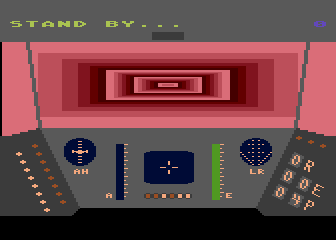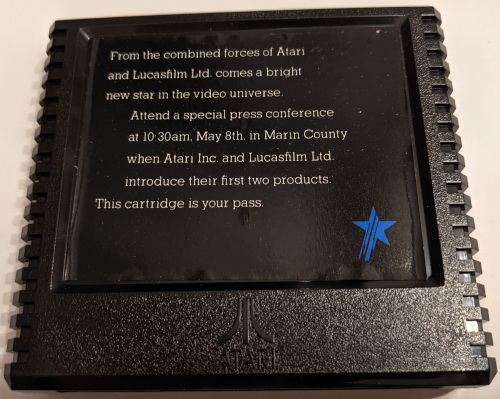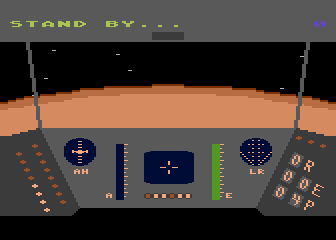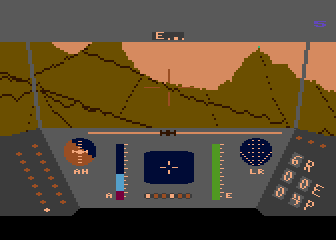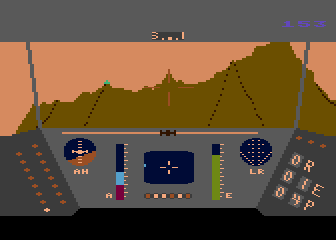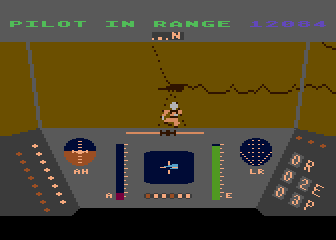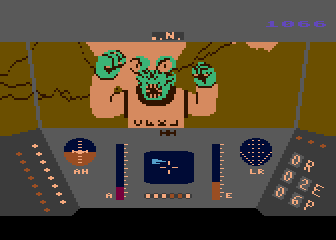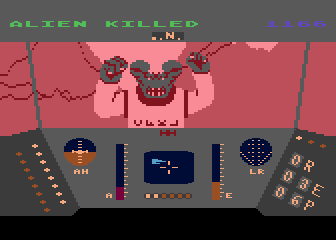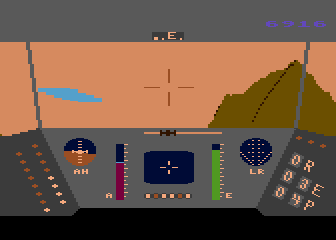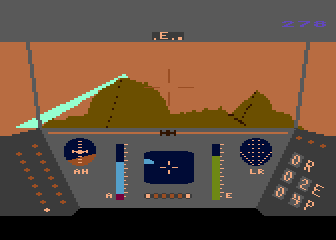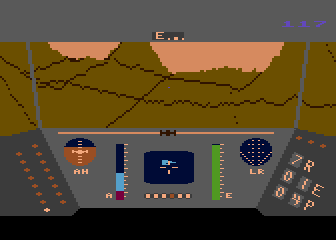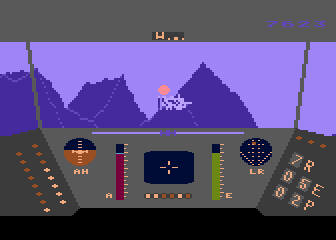|
|
Rescue on Fractalus
|
Name:
|
Rescue on Fractalus |
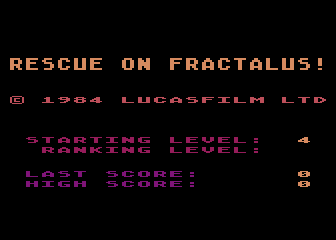 |
| Company: | Atari | |
|
Model #:
|
CX-5254 | |
|
Programmers:
|
David Fox, Loren Carpenter, Charlie Kellner, Peter Langston, Gary Winnick, and David Levine | |
| Year: | 1984 | |
|
Released?
|
Yes
|
|
|
Notes:
|
Prototype names include: Star Mission, Rescue Mission, and Behind Jaggi Lines |
In late 1983 as the 5200 was entering its final stage of life, LucasFilm (yes that LucasFilm) decided they wanted to take a shot at the videogame market. Although LucasFilm was a huge and successful company, they didn't have clue one on how to go about entering the highly competitive videogame market. So instead of floundering around like an amateur, LucasFilm wisely joined forces with Atari to publish its games. Unfortunately this partnership was to be short lived as their first two 5200 games, Ballblazer and Rescue on Fractalus, would be their last. However LucasFilm went on to publish several more games for the Atari 8-bit computer line under their own name.
To celebrate this historic partnership, Atari and Lucasfilm held a joint press conference on May 8th, 1984 to show off Ballblazer and Rescue on Fractalus. Instead of issuing the standard press passes, Atari and Lucasfilm sent attendees a special 5200 cartridge with a black label that they were to use as their pass. Very few of these passes are known to exist today.
Rescue on Fractalus remains to this day the most innovative 5200 games ever developed. One part flight sim, one part space shooter (add a pinch of Star Raiders and mix well), RoF is a fast paced action game with a healthy dose of strategy thrown in. Upon its release Rescue on Fractalus was immediately praised not only for its addictive gameplay, but also for its use of fractal geometry.
So what the heck are fractals you ask? Well since you asked.
A geometric pattern that is repeated at ever smaller
scales to produce irregular shapes and surfaces that cannot be
represented by classical geometry. Fractals are used especially
in computer modeling of irregular patterns and structures in
nature.
In other words a series of geometric patterns that make irregular shapes. Now where would fractals come in handy? How about to make jagged mountains? Yes that right, a very simple fractal algorithm was used to generate the mountainous terrain that makes up the planet of Fractalus. Even a very simple fractal generator takes up an enormous amount of resources, and since the largest 5200 games were only 24K (although they could go as large as 32K) there was very little memory left to work with. It's amazing that they were able to generate any fractals, much less the impressive scaling mountain range present in the game.
Your mission is to journey down to the planet of Fractalus (gee where did they come up with that name?) and rescue all the stranded pilots . Of course as you may have guessed the game isn't that easy. Fractalus just happens to be the stronghold of a evil race of aliens called the Jaggi, who want you dead in the worst possible way (why is it that you never find a friendly race of aliens in these games?). The Jaggi have place gun encampments all over the planets surface, so it's up to you to take them out before saving the pilots. Rescuing the pilots doesn't do any good if you're blown out of the sky upon take off. Take out the gun encampments by targeting them in the crosshairs and pressing the fire button. The trick to targeting the encampments is to watch where the flashes of light are coming from and shoot there.
Luckily for you the downed pilots have activated their homing beacons. These beacon signals allow you to track down where each pilot is located using the long-range scanner on the right hand side of your control panel (It's labeled LR in case you can't figure out which one it is!). As you fly near a stranded pilot a blip will appear on the scanner, this is your cue to start scanning the area for the downed ship. The scanner is in a V shape with your ship positioned at the bottom of the V, so take this into account when searching for pilots. Once you get close enough to the pilot the scanner will start flashing and beeping signaling that you should land and pick the pilot up.
Rescuing the pilot is as easy as 1-2-3 (literally). To make your rescue press the '1' key on the keypad and you should see your ship land. Once you're on the ground press the '2' key to turn off your engines and shields (you don't want to fry the guy), if you're in the right sport you should see the message "Pilot in Range". After a few seconds you will hear footsteps approach, this is the moment of truth. For you see not everything is as it seems. Those insidious Jaggi's have sent their own "rescue teams" to go kill the downed pilots, steal their flight suits, and pose as stranded pilots. Since all your computer sees is a homing beacon signal, there's no way of knowing who is approaching your ship. If you've landed near a Jaggi pilot a hideous alien will jump up and start banging on your windshield attempting to break in and wring your neck (I told you they hate you). To protect yourself, quickly press the '2' key to turn on your shields and fry the little bugger (if you haven't suffered a heart attack from the shock).
Now if you were overly trusting and decided to open your airlock BEFORE seeing exactly who was approaching your ship, the Jaggi will come inside your ship and start tearing it up. If this happens your only chance is to hit the thrusters and try and make it into space before the Jaggi kills you (they don't have any helmets to survive in space). However if you've landed near a human pilot you'll hear knocking on the door (Jaggi's don't knock), so press the '3' key to open up the airlock and let him in. Once he's safely inside make sure you destroy the downed ship otherwise Jaggi's will use it to spring their evil traps. Press '6' to take off again and go search for more pilots..
This would probably be a good time to explain exactly what all those little gauges are on your control panel. On the left are two columns of lights. The first one is your thrust level (adjusted with the '6' and '9' key), and the second is your Dangerous Altitude warning which lights up more and more the closer you are to hitting the ground. The circular gauge labeled AH is your Artificial Horizon which helps you keep the ship level (don't fly upside down!), and to the right of that is your altimeter which tells you how high you're flying (no not THAT kind of high!). The big display in the middle of the control panel is your Targeting Scope (go blast those Jaggi's!), and the lights underneath it represent the Enemy Lock On indicator. When all six of those lights light up the gun encampments will fire on you, so try and move around a bit to break the lock.
Above the Targeting Scope is the Wing Balance indicator. This gauge shows how close each of your wings are to the mountains (so you don't bang into them!). To the right of the Targeting Scope is your Energy Indicator, when this gets low it will beep and start to flash warning you to get back to the mother ship for refueling pronto! To the right of the Energy Indicator is the Long Range Radar (explained above) and the counting gauges. These gauges show various statistics such as the pilot's range from the ship (the top gauge), number of Jaggi guns destroyed (middle gauge), and the number of pilots left to rescue (bottom gauge). Above these gauges are three lights which indicate whether your shields are up (first light), if the mother ship is in range (middle light), and if your airlock is open (third light). Got all that?
Once you've rescued at least half of your quota of pilots the mother ship will appear in orbit. By pressing the '7' key you can fire your boosters and return to the mother ship for repairs and fuel. However until you fill your quota of rescued pilots you cannot finish the level and will be returned to the planet. If your ship is low on fuel or taking a lot of fire the mother ship may show up even without half the pilots being rescued. Once you've completed your quota and returned to the mother ship you will be rewarded bonus points based on the number of pilots rescued then advance to the next level. Starting on level four you will begin to encounter suicide saucers which will attempt to ram your ship. Thankfully these saucers can be taken down with torpedoes, but they're still very dangerous so use caution. On level 16 and above you'll begin to fly night missions. During these missions your screen will be completely black except for brief bursts of light from firing Jaggi guns. You'll have to use your instruments and wits alone to get through these missions in one piece. Thankfully the night only lasts four minutes (game time), but the sun will set again after an additional four minutes.
Originally Rescue on Fractalus was conceived a non-violent game rather than a shooter. During its prototyping phase (when the game was still known as Rescue Mission) your the ship had no guns, the only way to destroy the enemy was to lure them into the mountains (not an easy thing to do). In the summer of 83 when the first working build was shown to George Lucas he commented that he liked the game a lot, but wanted to know where the fire button was. After this meeting guns were added to the ship and a classic was born. Incidentally, in case your wondering where the name "Jaggi" comes from, it's actually a reference to a then new graphic technology called "anti-aliasing" (perhaps you've heard of it?). This technology used extra colors to smooth out the jagged diagonal graphics that plagued all computer games back then including Rescue of Fractalus (just look at the cockpit for a good example). Since there weren't enough colors on the Atari 5200 to use this technology the programmers declared that the "Jaggie" lines were their enemy and hence the Jaggi's were born. Rescue on Fractalus was almost released with the name "Behind Jaggi Lines", but Atari marketing nixed the idea since they feared that normal people wouldn't get the joke. A few prototypes with this name still exist.
With its innovative use of fractal geometry and fun addictive gameplay, Rescue on Fractalus is considered to by most to be the best 5200 games of all time. No other 5200 game comes close to pushing the system the way Rescue on Fractalus does. Unfortunately one of the side effects of pushing the system to its limits is that the framerate is a bit choppy, but considering the hardware was made in 1979 I think we can cut the game a little slack. Rescue on Fractalus is a game that belongs in every 5200 owners library, the fractal mountains alone are worth the price of admission. So what are you waiting for? Go blast those Jaggi's!
| Version | Cart Text | Description |
| 1/18/84 | Behind Jaggi 1-18-184 | Late beta |
| 2/13/84 | Behind Jaggi Line | Almost complete |
| 2/29/84 | ROF 2-29-84 | Has title on splash screen |
| ?/??/84 | Rescue on Fractalus | Final version |
| ?/??/84 | Rescue on Fractalus | Final version (Lucasfilm Label) |

